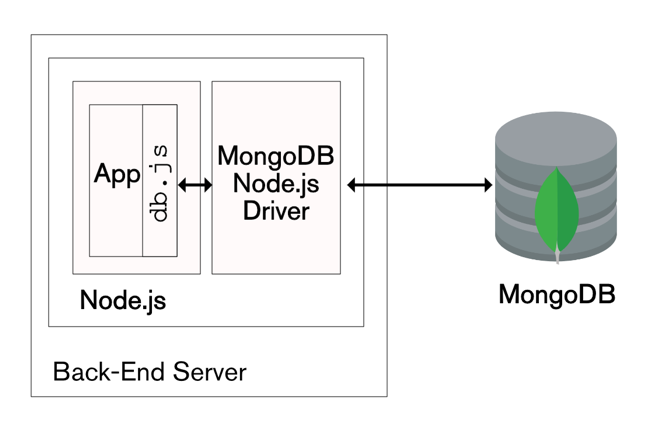Learning MongoDb with samples in Node Js
 ali bagheri
ali bagheri
Introduction to NoSQL Databases (MongoDB)
1. Overview of NoSQL Databases
NoSQL databases, like MongoDB, handle a wide variety of data models and offer flexibility, scalability, and high availability. MongoDB uses a document-oriented data model, storing data in JSON-like documents.
2. Setting Up a MongoDB Database
Installation
Download MongoDB from the official website.
Follow the installation instructions for your operating system.
Start the MongoDB server by running
mongod.
Creating a Database and Collections
In MongoDB, databases and collections are created implicitly when you first insert data into them.
// npm install mongodb --save
const { MongoClient } = require('mongodb');
const uri = "mongodb://localhost:27017";
// Create new instance of MongoDB
const client = new MongoClient(uri);
async function run() {
try {
// Connect to MongoDB
await client.connect();
// Create database and collections
const database = client.db('school');
const students = database.collection('students');
const classes = database.collection('classes');
const enrollment = database.collection('enrollment');
console.log('Database and collections created');
} finally {
await client.close();
}
}
run().catch(console.dir);
MongoDB Queries and Results
Common MongoDB Queries
- Insert Documents
await students.insertMany([
{ _id: 1, name: 'Alice', age: 14, grade: '9' },
{ _id: 2, name: 'Bob', age: 15, grade: '10' },
{ _id: 3, name: 'Charlie', age: 13, grade: '8' }
]);
await classes.insertMany([
{ _id: 1, class_name: 'Math', teacher: 'Mr. Smith' },
{ _id: 2, class_name: 'Science', teacher: 'Ms. Johnson' }
]);
await enrollment.insertMany([
{ student_id: 1, class_id: 1 },
{ student_id: 2, class_id: 1 },
{ student_id: 2, class_id: 2 }
]);
- Basic Find Query
const result = await students.find().toArray();
console.log(result);
// [
// {
// _id: new ObjectId('666300c8add741d7175c7de5'),
// name: 'Alice',
// age: 14,
// grade: '9'
// },
// {
// _id: new ObjectId('666300c8add741d7175c7de6'),
// name: 'Bob',
// age: 15,
// grade: '10'
// },
// {
// _id: new ObjectId('666300c8add741d7175c7de7'),
// name: 'Charlie',
// age: 13,
// grade: '8'
// }
// ]
- Filtering Data
const result = await students.find({ age: { $gt: 13 } }).toArray();
console.log(result);
// [
// {
// _id: new ObjectId('666300c8add741d7175c7de5'),
// name: 'Alice',
// age: 14,
// grade: '9'
// },
// {
// _id: new ObjectId('666300c8add741d7175c7de6'),
// name: 'Bob',
// age: 15,
// grade: '10'
// }
// ]
$gt: Stands for "greater than". This operator is used to filter documents where the field value is greater than the specified value.
- Sorting Data
const result = await students.find().sort({ grade: 1 }).toArray();
console.log(result);
// [
// {
// _id: new ObjectId('666300c8add741d7175c7de6'),
// name: 'Bob',
// age: 15,
// grade: '10'
// },
// {
// _id: new ObjectId('666300c8add741d7175c7de7'),
// name: 'Charlie',
// age: 13,
// grade: '8'
// },
// {
// _id: new ObjectId('666300c8add741d7175c7de5'),
// name: 'Alice',
// age: 14,
// grade: '9'
// }
// ]
1: In thesortmethod,1specifies ascending order. Use-1for descending order.
Joining Tables (Collections) with Aggregation
- Inner Join: Fetch students along with the classes they are enrolled in
const result = await enrollment.aggregate([
{
$lookup: {
from: 'students',
localField: 'student_id',
foreignField: '_id',
as: 'student_info'
}
},
{
$lookup: {
from: 'classes',
localField: 'class_id',
foreignField: '_id',
as: 'class_info'
}
},
{ $unwind: '$student_info' },
{ $unwind: '$class_info' },
{
$project: {
_id: 0,
student_name: '$student_info.name',
class_name: '$class_info.class_name'
}
}
]).toArray();
console.log(result);
// [
// { student_name: 'Alice', class_name: 'Math' },
// { student_name: 'Bob', class_name: 'Math' },
// { student_name: 'Bob', class_name: 'Science' }
// ]
$lookup: Performs a left outer join to a collection in the same database to filter in documents from the "joined" collection for processing.from: The target collection to join.localField: The field from the input documents.foreignField: The field from the documents in the "from" collection.as: The name of the new array field to add to the input documents.
$unwind: Deconstructs an array field from the input documents to output a document for each element.$project: Reshapes each document in the stream by including, excluding, or adding new fields._id: 0 excludes the_idfield.$student_info.name: Refers to thenamefield in thestudent_infosub-document.$class_info.class_name: Refers to theclass_namefield in theclass_infosub-document.
Updating Data
- Update a student's age
await students.updateOne(
{ name: 'Bob' },
{ $set: { age: 16 } }
);
$set: Sets the value of a field in a document.
- Update multiple fields
await students.updateOne(
{ name: 'Bob' },
{ $set: { age: 16, grade: '11' } }
);
$set: Sets the value of multiple fields in a document.
Deleting Data
- Delete a student
await students.deleteOne({ name: 'Charlie' });
- Delete all students in a specific grade
await students.deleteMany({ grade: '9' });
- Dropping Collections
await database.dropCollection('enrollment');
await database.dropCollection('students');
await database.dropCollection('classes');
Advanced MongoDB Queries
Subqueries
- Find students who are enrolled in at least one class
const result = await students.find({
_id: { $in: await enrollment.distinct('student_id') }
}).toArray();
console.log(result);
// [
// { _id: 1, name: 'Alice', age: 14, grade: '9' },
// { _id: 2, name: 'Bob', age: 15, grade: '10' }
// ]
$in: Matches any of the values specified in an array. Here, it checks if_idis in the array of distinctstudent_ids from theenrollmentcollection.
- Find classes with more than one student enrolled
const result = await classes.find({
_id: {
$in: await enrollment.aggregate([
{ $group: { _id: '$class_id', count: { $sum: 1 } } },
{ $match: { count: { $gt: 1 } } }
]).map(doc => doc._id).toArray()
}
}).toArray();
console.log(result);
// [
// { _id: 1, class_name: 'Math', teacher: 'Mr. Smith' },
// { _id: 2, class_name: 'Science', teacher: 'Ms. Johnson' }
// ]
$group: Groups documents by a specified identifier expression and applies an accumulator expression to each group._id: '$class_id': Groups byclass_id.count: { $sum: 1 }: Counts the number of documents in each group.
$match: Filters the documents.count: { $gt: 1 }: Filters groups where the count is greater than 1.
Union
- List all student names and class names in one array
const studentNames = await students.distinct('name');
const classNames = await classes.distinct('class_name');
const allNames = studentNames.concat(classNames);
console.log(allNames);
// [ 'Bob', 'Math', 'Science' ]
Case Statements (Aggregation with $cond)
- Categorize students by age group
const result = await students.aggregate([
{
$project: {
name: 1,
age_group: {
$cond: {
if: { $lt: ['$age', 14] },
then: 'Junior',
else: {
$cond: {
if: { $lt: ['$age', 16] },
then: 'Intermediate',
else: 'Senior'
}
}
}
}
}
}
]).toArray();
console.log(result);
// [
// {
// _id: new ObjectId('666300c8add741d7175c7de6'),
// name: 'Bob',
// age_group: 'Senior'
// }
// ]
$project: Reshapes each document in the stream by including, excluding, or adding new fields.name: 1: Includes thenamefield.age_group: Adds a new field.
$cond: Evaluates a boolean expression to return one of the two specified values.if: The condition to evaluate.then: The value to return if the condition is true.else: The value to return if the condition is false.
$lt: Checks if one value is less than another.
Nested Queries
- Find the names of students who are enrolled in the same class as "Bob"
const bobId = (await students.findOne({ name: 'Bob' }))._id;
const bobClasses = await enrollment.distinct('class_id', { student_id: bobId });
const result = await students.find({
_id: { $in: await enrollment.distinct('student_id', { class_id: { $in: bobClasses } }) }
}).toArray();
console.log(result);
// [
// { _id: 1, name: 'Alice', age: 14, grade: '9' },
// { _id: 2, name: 'Bob', age: 15, grade: '10' }
// ]
$in: Matches any of the values specified in an array.
- Find students with grades higher than the average grade
const avgGrade = await students.aggregate([
{ $group: { _id: null, avgGrade: { $avg: '$grade' } } }
]).toArray();
const result = await students.find({ grade: { $gt: avgGrade[0].avgGrade } }).toArray();
console.log(result);
// [
// { _id: 2, name: 'Bob', age: 15, grade: '10' }
// ]
$group: Groups documents by a specified identifier expression and applies an accumulator expression to each group._id: null: No specific grouping, so all documents are aggregated into one group.avgGrade: { $avg: '$grade' }: Calculates the average grade.
$avg: Computes the average of the numeric values that result from applying a specified expression to each document in a group.
Complex Join with Aggregation
- Fetch the number of students in each class
const result = await classes.aggregate([
{
$lookup: {
from: 'enrollment',
localField: '_id',
foreignField: 'class_id',
as: 'enrollments'
}
},
{
$project: {
class_name: 1,
student_count: { $size: '$enrollments' }
}
}
]).toArray();
console.log(result);
// [
// {
// _id: new ObjectId('666300c8add741d7175c7de8'),
// class_name: 'Math',
// student_count: 0
// },
// {
// _id: new ObjectId('666300c8add741d7175c7de9'),
// class_name: 'Science',
// student_count: 0
// }
// ]
- Fetch the class with the highest number of students
const result = await classes.aggregate([
{
$lookup: {
from: 'enrollment',
localField: '_id',
foreignField: 'class_id',
as: 'enrollments'
}
},
{
$project: {
class_name: 1,
student_count: { $size: '$enrollments' }
}
},
{ $sort: { student_count: -1 } },
{ $limit: 1 }
]).toArray();
console.log(result);
// [
// {
// _id: new ObjectId('666300c8add741d7175c7de8'),
// class_name: 'Math',
// student_count: 0
// }
// ]
Change Stream (Triggers)
const pipeline = [
{ $match: { operationType: { $in: ['insert', 'update', 'delete'] } } }
];
const changeStream = students.watch(pipeline);
changeStream.on('change', async (next) => {
const action = next.operationType.toUpperCase();
const studentId = next.documentKey._id;
await studentsHistory.insertOne({ action_time: new Date(), student_id: studentId, action: action });
console.log(`Logged ${action} action for student_id: ${studentId}`);
});
$match: Filters the documents.operationType: Specifies the type of operation (insert,update, ordelete).
$in: Matches any of the values specified in an array.
Summary
In this comprehensive guide, we explored the concepts and practical implementations of MongoDB, a popular NoSQL database, by creating and manipulating collections that represent students, classes, enrollments, and students' history.
Collection Creation:
- We created structured collections for
students,classes,enrollment, andstudents_history. Each collection's fields and data types were defined, with unique identifiers generated by MongoDB'sObjectId.
- We created structured collections for
Data Manipulation:
Insert Operations: Examples demonstrated how to insert documents into collections, including nested documents to represent relationships between students and classes.
Update Operations: The use of the
$setoperator to update specific fields within documents was showcased.Delete Operations: Techniques for deleting specific documents based on conditions were provided.
Advanced Queries:
Nested Queries: We covered how to perform complex queries such as aggregations, sorting, filtering, and projecting specific fields from nested documents.
Aggregation Pipeline: The use of MongoDB's powerful aggregation framework to perform multi-stage data transformations and calculations was explained, with examples of
$match,$group,$project, and$lookupstages.
Change Streams:
- Simulating Triggers: We set up change streams to monitor real-time changes (inserts, updates, deletes) in the
studentscollection and log these actions in thestudents_historycollection, effectively simulating the behavior of SQL triggers.
- Simulating Triggers: We set up change streams to monitor real-time changes (inserts, updates, deletes) in the
Conclusion
This guide has provided a thorough understanding of MongoDB's capabilities, from basic operations to advanced queries and real-time change tracking. By mastering these techniques, you can effectively manage and manipulate data in a NoSQL database, leveraging MongoDB's flexibility and scalability.
Key takeaways include:
The ability to design well-structured collections that represent real-world entities and their relationships.
Proficiency in performing CRUD (Create, Read, Update, Delete) operations to manage data within MongoDB.
The skills to construct complex queries using MongoDB's aggregation framework for sophisticated data analysis.
Knowledge of change streams to monitor and react to real-time data changes, ensuring robust data integrity and auditing.
By applying these concepts and techniques, you can harness the full power of MongoDB to build efficient, scalable, and maintainable data-driven applications.
Subscribe to my newsletter
Read articles from ali bagheri directly inside your inbox. Subscribe to the newsletter, and don't miss out.
Written by

ali bagheri
ali bagheri
A passionate software engineer with experience in developing scalable web applications and robust backend systems since 2019. My expertise in Golang, JavaScript, TypeScript, Python and C# , combined with a deep love for coding, drives my commitment to creating elegant, efficient solutions. I thrive in collaborative environments and believe in the power of teamwork to achieve the best results.